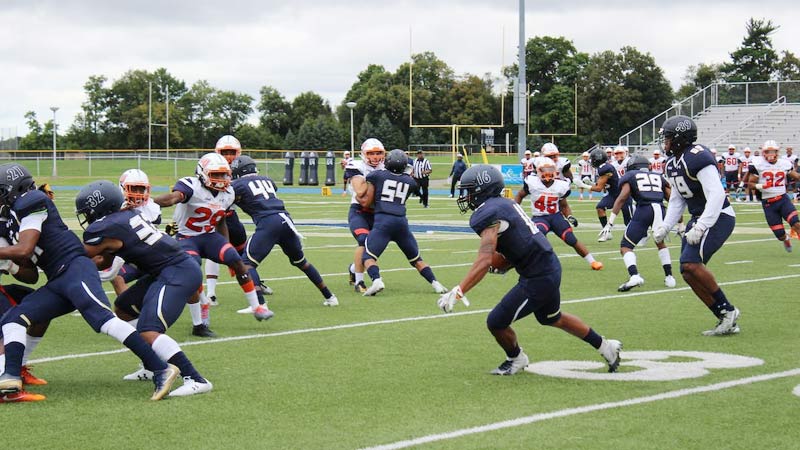Exploring the realm of American Football involves delving into various facets that make this sport an iconic cultural phenomenon. Among these elements, the “Field of Play” stands as the fundamental battleground where epic clashes unfold.
The American Football field is more than just a rectangular expanse; it holds strategic significance, dictating player formations, scoring opportunities, and crucial coaching decisions.
Well, in this blog post, we unravel the mysteries of the Field of Play, shedding light on its dimensions, key markings, and how it shapes the game’s dynamics.
Whether you’re a seasoned fan seeking a refresher or a newcomer eager to understand the sport’s foundation, our comprehensive guide will navigate you through the intricate intricacies of the gridiron, deepening your appreciation for the captivating spectacle of American Football.
What is the Field of Play in American Football?
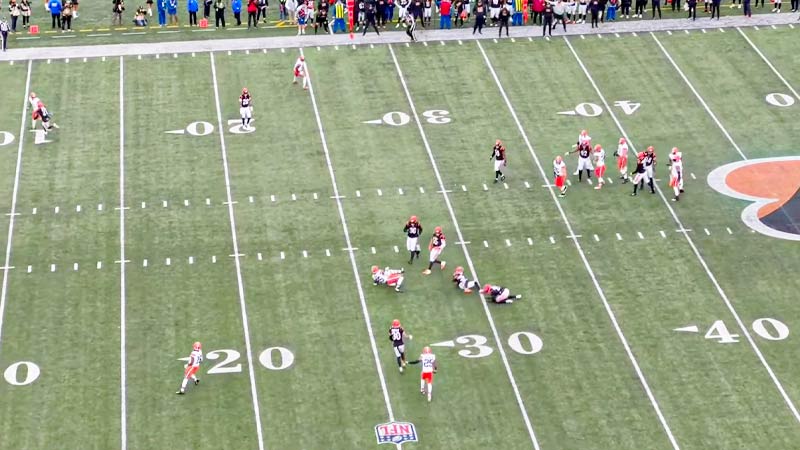
The Field of Play in American Football refers to the designated playing area where the game is conducted. It is a rectangular-shaped field with specific markings and dimensions.
The field is divided into several sections, each serving a unique purpose during the game. Here are the key elements of the Field of Play in American Football:
Dimensions
The standard football field is 100 yards long (300 feet) and 53.3 yards wide (160 feet). The field is divided into two equal halves by the 50-yard line, with end zones on both ends.
End Zones
Located at each end of the field, the end zones are areas measuring 10 yards deep where teams attempt to score touchdowns. They are marked by a goal line at the front and a back line at the end.
Yard Lines
The field is marked with parallel lines running the width of the field and spaced 5 yards apart. These lines are numbered every 10 yards (e.g., 10, 20, 30, etc.) from the goal line at each end.
Hash Marks
These short lines are placed parallel to the yard lines, closer to the center of the field. They are used to indicate where the ball should be spotted before each play.
Sidelines
The two long boundaries running the length of the field are called sidelines. They mark the outermost boundaries of the playing area.
Goal Posts
Positioned at the back of each end zone, the goal posts consist of two vertical uprights connected by a horizontal crossbar. Teams attempt field goals and extra points by kicking the football through the goalposts.
During the game, teams try to advance the ball down the field by running or passing, aiming to score points by reaching the opponent’s end zone. The field is marked to facilitate the game’s progress, positioning of players, and determination of first downs.
Each team defends one end zone and tries to prevent the other team from scoring while trying to score themselves in the opposite end zone. The team with the most points at the end of the game wins.
How the Field is Marked in American Football?
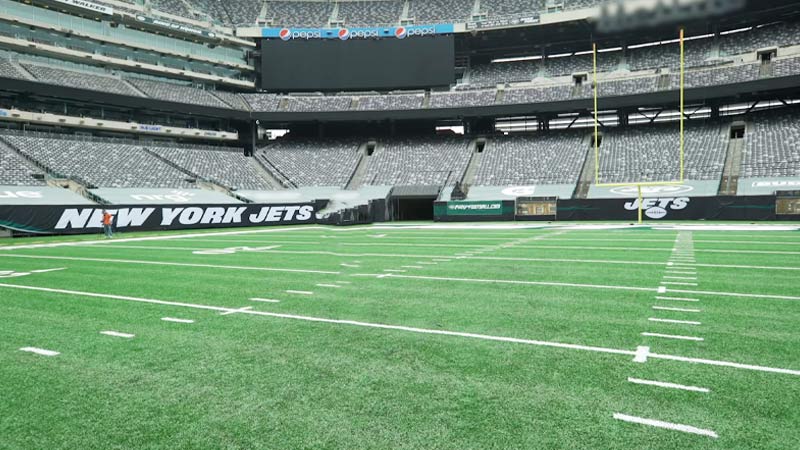
The field in American Football is marked using a combination of white lines and other specific markings that indicate various zones and measurements. Here’s how the field is typically marked:
Yard Lines
The field is marked with parallel lines that run the width of the field and are spaced 5 yards apart. These lines are numbered every 10 yards, starting from the goal line at each end zone. They are used to indicate the distance the offense needs to advance the ball to achieve a first down or score a touchdown.
Hash Marks
These short lines are placed closer to the center of the field between each pair of yard lines. They are used to determine the placement of the football before each play. The ball is spotted on the hash mark where the previous play ended, ensuring a fair and accurate starting point for the next play.
Goal Lines
The goal lines mark the front edge of each end zone. When the offense crosses the opponent’s goal line with the football, it results in a touchdown.
End Lines
These lines mark the back edges of the end zones, defining the boundary of the playing field.
Sidelines
The sidelines run the length of the field and mark the outer boundaries of the playing area. Players must stay on the sidelines during the game.
50-Yard Line
The 50-yard line is the center of the field and divides it into two equal halves. It is commonly marked with the team logos or name of the home team.
Inbounds and Out-of-Bounds Markers
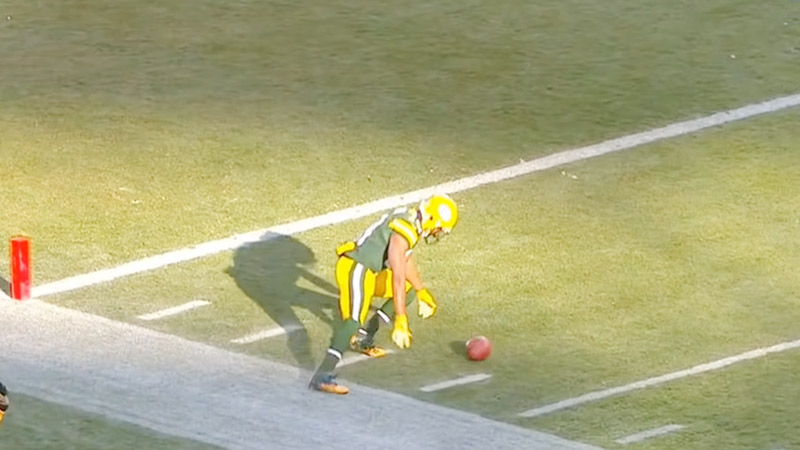
On the sidelines, there are small markers or cones placed at regular intervals to indicate the inbounds area of the field. If a player carrying the ball or catching a pass steps out of bounds, the play is considered dead.
Goal Posts
Positioned at the back of each end zone, the goal posts consist of two vertical uprights connected by a horizontal crossbar. They are used for field goal attempts and extra-point kicks.
Coaches’ Boxes
On each side of the field, there are designated areas for the head coaches to stand and communicate with their players during the game. These areas are marked by lines on the sideline.
These markings help the players, officials, and spectators understand the position of the ball, the distance to go for a first down or a score, and other important aspects of the game. The Field markings play a crucial role in the fair and organized conduct of American Football games.
What Is Out of the Bound in the Context of the Field of Play
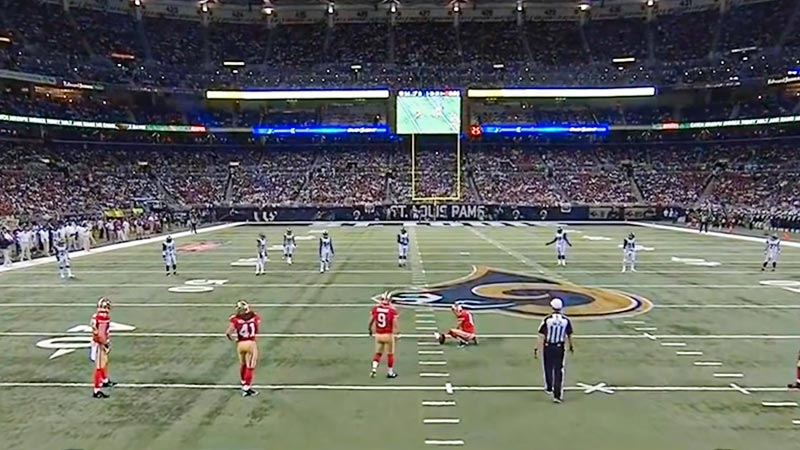
In the context of the Field of Play in American Football, “Out of Bounds” refers to any part of the field where a player or the football crosses or touches the boundary lines that mark the outer edges of the playing area.
When a player or the ball goes out of bounds, it has significant implications for the ongoing play. Here’s what it means:
Ball Carrier
If the player carrying the football steps or is forced out of bounds, the play is considered dead. The ball is spotted at the point where the player went out of bounds, and the game clock stops. When the next play begins, it starts from that spot on the field.
Completed Pass
If a pass is caught by a receiver and manages to land in bounds with at least one foot while maintaining possession of the ball, it is considered a completed pass. However, if the receiver catches the ball and touches the ground with any part of their body or the ball out of bounds, the pass is ruled incomplete.
Touchdowns and Touchbacks
To score a touchdown, a player carrying the ball must cross the goal line and break the plane of the end zone (i.e., the invisible vertical plane extending upwards from the goal line). If the ball or player goes out of bounds before crossing the goal line, it is not a touchdown.
If the ball carrier fumbles the ball out of bounds in the opponent’s end zone, it results in a touchback, and the defensive team gains possession at their 20-yard line.
Kickoff and Punt Returns
In special teams’ plays, the returner must stay in bounds to advance the ball. If they step out of bounds while trying to return a kickoff or a punt, the play is dead, and the ball is placed at the spot where they went out of bounds.
Lateral Plays
On lateral plays (lateral passes or pitches), the ball can be thrown or pitched backward or sideways. However, if the ball is thrown forward and goes out of bounds, it is an incomplete pass.
Going out of bounds usually stops the clock, which can be advantageous for the offense when they are trying to save time or disadvantageous if the clock is running and the team is attempting to mount a late-game comeback.
On the other hand, the defense benefits from stopping a play by forcing the ball carrier out of bounds. The boundary lines and the concept of being “Out of Bounds” play a crucial role in defining the limits of the playing area and determining the outcome of various plays in American Football.
Significance of the Field of Play in American Football
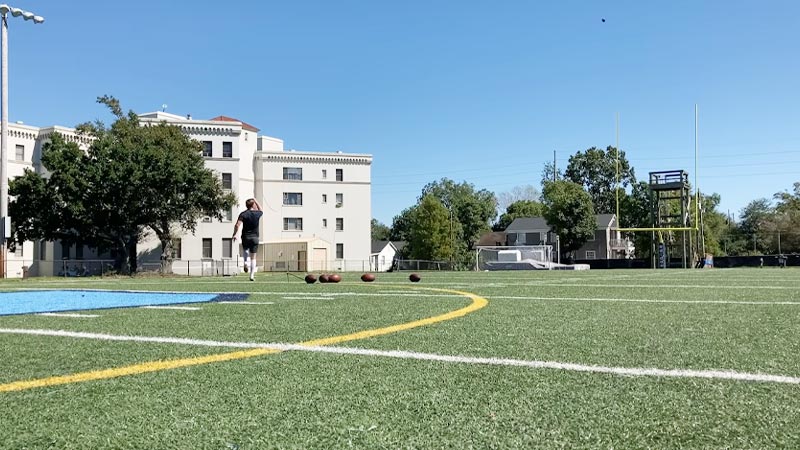
The Field of Play in American Football holds significant importance as it serves as the stage for the entire game and plays a crucial role in shaping the dynamics and strategies of the sport. Here are some key significances of the field:
Game Execution
The field provides a designated and standardized area where the game can be conducted. It offers clear boundaries for the players and officials to follow, ensuring fair competition and preventing any confusion regarding the playing area.
Scoring Opportunities
The field’s layout, particularly the end zones, provides the primary scoring opportunities in American Football. Teams strive to advance the ball into the opponent’s end zone to score touchdowns, while kickers attempt field goals through the goalposts in the same area.
Yardage and Down Progression
The yard lines and hash marks on the field help determine the distance a team needs to advance the ball for a first down or a score. They play a vital role in the game’s progression, setting up potential plays, and assessing a team’s offensive and defensive strategies.
Boundaries and Out-of-Bounds
The sidelines and end lines define the boundaries of the playing area. Going out of bounds impacts the ongoing play, as it determines where the ball is spotted and whether the clock should stop. This adds an element of strategy and control to the game.
Formation and Alignment
The field’s dimensions dictate how players align and position themselves on offense and defense. It influences the formations and strategies teams employ to gain an advantage over their opponents.
Home-Field Advantage
The home team enjoys the benefits of familiarity with their home field, including crowd support, knowledge of field conditions, and familiarity with the stadium’s dimensions. This home-field advantage can influence the outcome of games.
Surface Conditions
Different stadiums may have natural grass or artificial turf, which can affect the players’ footing and overall game dynamics. The surface conditions can be a factor in how the game is played and can impact players’ performance.
Coaching Decisions
Coaches often make critical decisions based on field position, score, and remaining time. The field’s dimensions and the team’s location on the field can influence play-calling and game strategies.
Spectator Experience
The field provides a clear view of the game for spectators, enabling them to watch the action unfold and be engaged in the excitement of American Football.
The Field of Play in American Football is more than just a playing area; it sets the stage for the entire game, shapes the strategies and decisions of teams, and defines the boundaries that players must follow to compete effectively.
Its design and markings facilitate fair competition and contribute significantly to the sport’s dynamics and excitement.
FAQs
What are the dimensions of the American Football field?
The standard American Football field is 100 yards long (300 feet) and 53.3 yards wide (160 feet). The field is divided into two equal halves by the 50-yard line, with each end featuring an end zone where touchdowns are scored.
What are the key markings on the field?
The field is marked with yard lines, each 5 yards apart, indicating the distance needed to gain a first down or score. Hash marks are present closer to the center of the field, helping to spot the ball before each play. Additionally, the goal lines and end lines define the boundaries of the end zones.
How does going “Out of Bounds” impact the game?
When a player or the football crosses the boundary lines, known as “Out of Bounds,” the play is considered dead. The ball is then spotted at the point where it went out of bounds, and the game clock stops. This has significant implications for the ongoing play and can influence the team’s strategy.
How does the field shape team strategies?
The layout of the field influences offensive and defensive strategies, including formation, alignment, and play-calling decisions. Coaches often take into account the field position, distance to the end zone, and remaining time when devising their game plans.
Why is the field important for home-field advantage?
The home team gains certain advantages due to their familiarity with their home field. Crowd support, knowledge of field conditions, and understanding the stadium’s dimensions can all contribute to the home-field advantage in American Football.
Wrapping Up
The Field of Play is the canvas upon which American Football’s exhilarating battles unfold. Its dimensions, markings, and boundaries serve as critical elements that shape the strategies, scoring opportunities, and overall dynamics of the game.
Understanding the field’s significance not only deepens our appreciation for the sport but also allows us to grasp the strategic nuances that make American Football an enthralling spectacle loved by millions worldwide.
So, next time you watch a game, keep an eye on the field, and you’ll find a deeper understanding of the gridiron battles that captivate fans every season. Thank you for staying with us till now.

